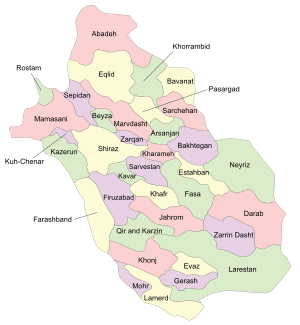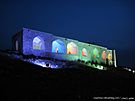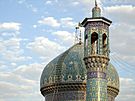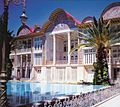Fars province facts for kids
Quick facts for kids
Fars Province
استان فارس
|
|
|---|---|
|
Clockwise from top left: the Tomb of Cyrus the Great in Pasargadae; Arg of Karim Khan in Shiraz; a canola field in Alamarvdasht; Bishapur valley; Naqsh-e Rostam; and ruins of the Tachara in Persepolis
|
|
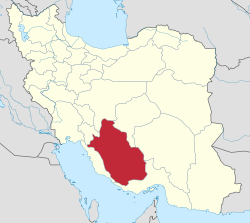
Location of Fars province within Iran
|
|
| Country | Iran |
| Region | Region 2 |
| Capital | Shiraz |
| Counties | 37 |
| Area | |
| • Total | 122,608 km2 (47,339 sq mi) |
| Population
(2016)
|
|
| • Total | 4,851,274 |
| • Estimate
(2020)
|
5,051,000 |
| • Density | 39.56735/km2 (102.4790/sq mi) |
| Time zone | UTC+03:30 (IRST) |
| Area code(s) | 071 |
| ISO 3166 code | IR-07 |
| Main language(s) | |
| Fars Province Historical Population | ||
|---|---|---|
| Year | Pop. | ±% |
| 2006 | 4,220,721 | — |
| 2011 | 4,596,658 | +8.9% |
| 2016 | 4,851,274 | +5.5% |
Fars Province (/fɑːrs/; Persian: استان فارس, Ostân-e Fârs), also known as Pars Province, is one of Iran's 31 provinces. It is located in the southwest of Iran. The capital city of Fars Province is Shiraz.
Fars Province covers an area of about 122,400 square kilometers. It borders several other provinces, including Bushehr, Hormozgan, Kerman, Yazd, Isfahan, and Kohgiluyeh and Boyer-Ahmad.
In 2016, about 4.85 million people lived in Fars Province. Most of them (about 67.6%) lived in cities. The rest lived in villages or were nomadic tribes.
Fars is the ancient home of the Persian people. It was the center of powerful empires like the Achaemenid Empire and the Sasanian Empire. These empires ruled ancient Persia. You can still see the ruins of their capitals, Pasargadae and Persepolis, in Fars. Because of its important history, the whole country of Iran was often called "Persia" in the West.
Contents
The Name of Fars Province
The word Fârs (فارس) comes from an older word, Pârs (پارس). This word itself came from Pârsâ, which was the Old Persian name for this region. The names "Parsa" and "Persia" both come from this area.
Cities and Population
Many people in Fars Province live in cities. The capital, Shiraz, is the largest city. Here are some of the most populated cities in Fars Province, based on the 2016 census:
| Rank | City | County | Population | ||
|---|---|---|---|---|---|
| 1 | Shiraz | Shiraz | 1,565,572 | ||
| 2 | Marvdasht | Marvdasht | 148,858 | ||
| 3 | Jahrom | Jahrom | 141,634 | ||
| 4 | Fasa | Fasa | 110,825 | ||
| 5 | Kazerun | Kazerun | 96,683 | ||
| 6 | Sadra | Shiraz | 91,863 | ||
| 7 | Darab | Darab | 70,232 | ||
| 8 | Firuzabad | Firuzabad | 65,417 | ||
| 9 | Lar | Larestan | 62,045 | ||
| 10 | Abadeh | Abadeh | 59,116 |
People and Cultures
The main group of people in Fars Province are Persians. This includes the Larestani people and the Basseri. There are also smaller groups, called minorities. These include the Qashqai, Lurs, Arabs, Kurds, Georgians, and Circassians.
Because of its location near the Persian Gulf, Fars has been home to many different groups over time. Many tribes in Fars, like the Mamasani Lurs and Khamseh, have kept their unique cultures. Their traditions are an important part of Iran's heritage. This attracts many tourists to the area.
Some Kurdish tribes in Fars include Uriad, Zangana, Chegini, Kordshuli, and Kuruni. Long ago, many Georgians and Circassians were brought to Persia. Some were settled in Fars to guard trade routes. Over time, most of these groups became part of the local population.
History of Fars Province
Ancient Empires
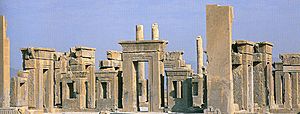
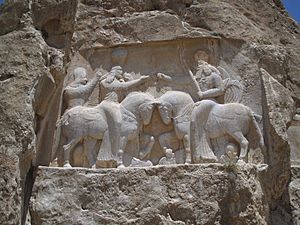
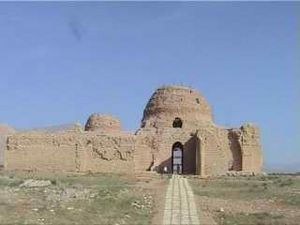
The ancient Persians lived in this region around 1000 BC. They later created the Achaemenid dynasty, one of the largest empires the world had ever seen. This empire started in the mid-6th century BC. It stretched from parts of Europe in the west to the Indus Valley in the east.
The ruins of Persepolis and Pasargadae are in Fars. These were two of the four capitals of the Achaemenid Empire.
In 333 BC, Alexander the Great defeated the Achaemenid Empire. After this, the Seleucid Empire took control of much of the land. However, they did not have strong control over Fars.
Later, the Parthian Empire defeated the Seleucids in 238 BC. But by 205 BC, the Seleucid king Antiochus III took back control of Fars.
Rise of the Sasanian Empire
A local ruler named Babak started to gain power in Fars. His son, Shapur, helped him expand their control. After Babak died around 220 AD, his other son, Ardashir I, became governor. Ardashir moved his capital to Ardashir-Khwarrah (now Firouzabad).
Ardashir quickly expanded his power. He took control of nearby provinces like Kerman and Isfahan. In 224 AD, Ardashir defeated the Parthian Emperor. In 226 AD, Ardashir was crowned as the sole ruler of Persia. This ended the 400-year rule of the Parthian Empire. It began the Sasanian Empire, which lasted for over 400 years. This empire made Persia a leading power again.
The Sasanian Empire ruled until the Muslim armies conquered the empire. After this, many Persians began to convert to Islam. This helped the new Muslim empire spread Islam further.
Fars Province has many historical sites from different dynasties. These monuments show the rich history of the region and Iran. The ruins of Bishapur, Persepolis, and Firouzabad are examples of these.
Climate and Wildlife
Fars Province has three different climate zones.
- The northern and northwestern mountains have cool, cold winters and mild summers.
- The central areas have mild, rainy winters and hot, dry summers.
- The southern and southeastern regions have cold winters and hot summers.
The average temperature in Shiraz is about 16.8 °C (62.2 °F).
The different climates lead to many types of plants and animals. Many birds migrate to Fars Province each year. These include ducks, storks, and swallows. The native animals of Fars include gazelles, deer, mountain wild goats, and various birds. In the past, the Persian lion also lived here.
Fars Province has several protected areas for wildlife:
- Toot Siah (Black Berry) Hunt Forbidden Zone, in the Boanat region.
- Basiran Hunt Forbidden Zone, south of Abadeh.
- Bamu National Park, northeast of Shiraz.
- Estahban Forest Park, near Touraj mountain.
- Hermoodlar Protected Zone, east of Larestan.
Arjan Meadow and Lake Parishan are important wetlands. They are recognized internationally for their natural value.
Economy and Education
Agriculture is very important in Fars. Farmers grow crops like wheat, barley, citrus fruits, dates, sugar beets, and cotton.
Fars also has large factories. These include petrochemical plants, an oil refinery, a tire factory, and electronics industries. There is also a sugar mill. Tourism is a big industry in the province. A special area called Arzhan (also known as Dasht e Arjan) is a biosphere reserve recognized by UNESCO.
Shiraz, the capital of Fars, is famous for its historical connection to Shirazi wine. In the past, there were many wine factories in the city.
Transportation
Shiraz Airport is the main international airport in Fars Province. It is the second busiest airport in Iran. Other cities like Jahrom, Lar, and Lamerd also have airports. These connect them to Shiraz, Tehran, and nearby countries. Shiraz is also on the main road from Tehran to southern Iran.
Higher Education
Fars Province has many universities and colleges. Some of the main ones are:
- Shiraz University
- Shiraz University of Arts
- Shiraz University of Medical Sciences
- Shiraz University of Technology
- Jahrom University
- Jahrom University of Medical Sciences
- Fasa University of Medical Sciences
- Islamic Azad University of Shiraz
- Islamic Azad University of Jahrom
Famous People from Fars Province
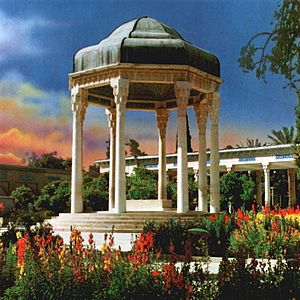

- Cyrus the Great: He founded the Achaemenian Empire.
- Ardashir I: He founded the Sasanian Empire.
- Karim Khan: He founded the Zand dynasty.
- Lotf Ali Khan: The last ruler of the Zand dynasty.
- Saadi: A famous writer and poet born and died in Shiraz.
- Hafez Shirazi: A famous poet born and died in Shiraz.
- Barbad: A Persian musician from the Sasanid era, born in Jahrom.
- Mulla Sadra: An important Islamic philosopher and theologian.
- Qotb al-Din Kazeruni: Born in Kazerun.
- Mansur Hallaj: A Persian mystic.
- Salman the Persian: A companion of the Islamic prophet Muhammad. He was the first Persian to become a Muslim.
- Reza Malekzadeh: Born in Kazerun.
- Christiane Amanpour: Her father is from Sarvestan, Fars.
- Sibawayh: One of the founders of Arabic grammar, died in Shiraz.
- Hakim Salman Jahromi: A special doctor for Abbas the Great, from Jahrom.
- Ibn Muqaffa: A Persian writer and translator.
- Zahra Kazemi: A photographer born in Shiraz.
- Ladan and Laleh Bijani: Famous conjoined twins born in Shiraz.
- Khwaju Kermani: Buried in Shiraz.
- Jamshid Amouzegar
- Seyyed Zia'eddin Tabatabaee: Born in Shiraz.
- Ibn Khafif: A 9th-century wise person, buried in Shiraz.
- Sheikh Ruzbehan
- Afshin Ghotbi: A football manager.
- Meulana Shahin Shirazi: A Persian Jewish poet.
- Junayd Shirazi
- Mohsen Kadivar
- Ata'ollah Mohajerani: A politician from Shiraz.
- Saeed Emami
- Gholam Reza Azhari
- Siyyid Mírzá 'Alí-Muhammad: Known as the Báb.
- Mohammad Hashem Pesaran: A highly respected Iranian economist.
- Firouz Naderi: An Iranian-American scientist who worked at NASA's Jet Propulsion Laboratory. He was born in Shiraz.
- Ebrahim Golestan: A filmmaker and writer.
- Kaveh Golestan: A photojournalist and artist.
- Habibollah Peyman: An Iranian politician.
- Mohsen Safaei Farahani: An Iranian politician.
- Simin Daneshvar: A well-known novelist and translator.
Images for kids
See also
 In Spanish: Provincia de Fars para niños
In Spanish: Provincia de Fars para niños








